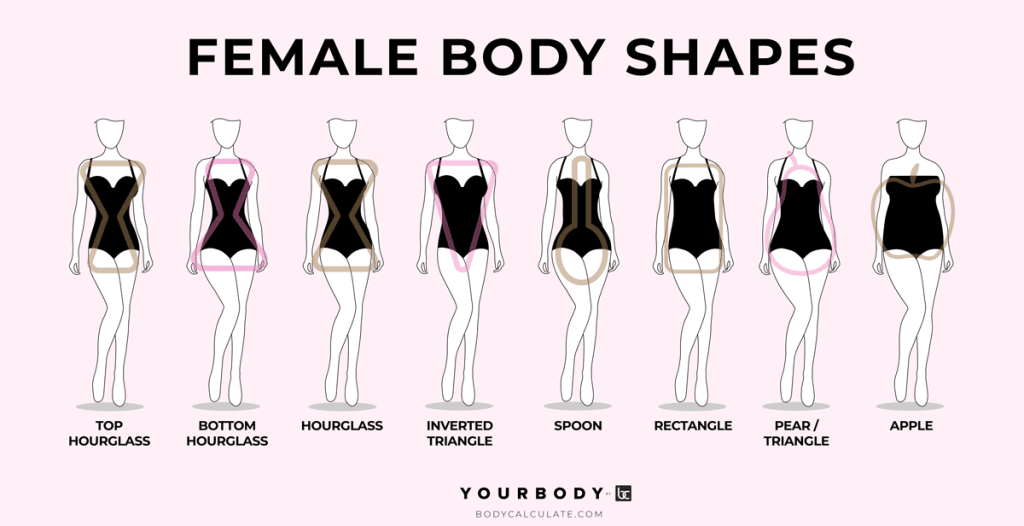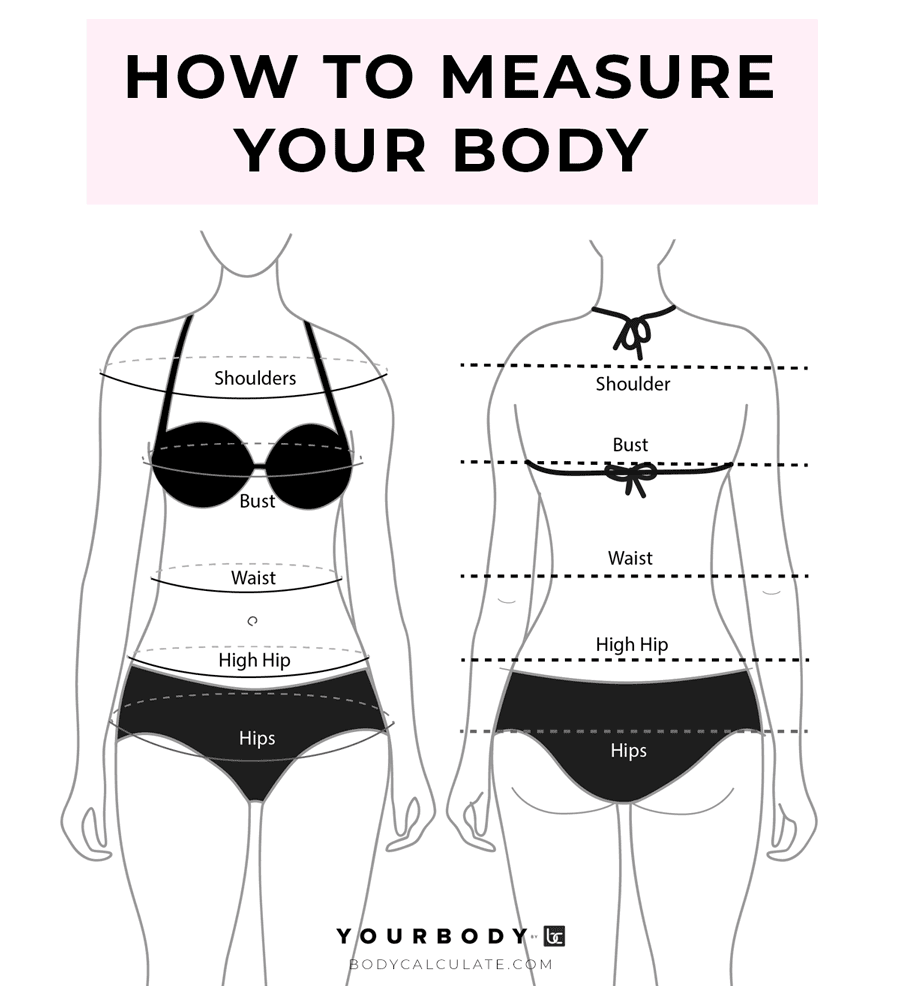A body shape calculator is an online tool designed to determine what body shape your measurements resemble most. The most common measurements needed when calculating your body shape are the circumference measurements of the shoulder or bust, waist, hip and sometimes high hip.
Once a body shape calculator has all required measurements, the algorithm of the calculator will calculate the ratios and differences between the different body areas to determine the body shape category your body resembles the most.
Body Shape Categories Include:
- Rectangle (or banana) – where your bust, waist, and hip measurements are relatively close.
- Hourglass – where your bust and hips are approximately the same width with a noticeably narrower waist.
- Pear (or triangle) – where your hips are wider than your bust and waist.
- Inverted Triangle – where your bust is broader than your hips.
- Apple (or round) – where your waist is broader than your bust and hips.
- Bottom Hourglass –where you have met the hourglass requirements except have wider hips.
- Top Hourglass – where your bust or shoulders are broader than your hips or waist with a noticeably narrower waist.
- Spoon – where your shoulders bust are narrow with a more pronounced difference between the waist and hips than a pear.

How to Use a Body Shape Calculator
- Find Measurements: Use a soft measuring tape, like a sewing measuring tape, measure your shoulders, bust, waist, hips and high hip. See
- Input Measurements: Enter each measurement into the calculator.
- Results: The calculator will then try to match your measurements with a body shape. You could end up with multiple shapes you resemble.
How to Measure your Body
The easiest way to check what your body shape is to measure your shoulders, bust, waist, hips and high hip.
How and What to Measure:
- Shoulders: Measure around your shoulders and back.
- Bust: Measure around the widest part of your chest, the tape measure needs to be level fully around your bust and back.
- Waist: Measure around the smallest part of your natural waistline, typically 1- 3 inches above your belly button. Keep you mid section relaxed and no sucking in or pushing out.
- Hips: Measure around the widest part of your hips and buttocks.
- High Hip: Measure around your high hip, which is commonly 1-3 inchces below your belly button, or where “low-rise” jeans might sit.

How to Work out Your Body Shape Manually
There are many different methods to ascertain the silhouette or body shape of your figure. Some equations use set ratios and some use an algorithmic comparison method. We have listed popular equations for either ratio and comparison methods below for each shape.
Rectangle (or banana):
The first method using ratios works out if:
Your waist is less than 25% smaller than your shoulders
OR Your waist is less than 25% smaller than your bust
Your bust and hip are within 5% of each other.
The second method using algorithmic comparison compares:
The difference between your hip and bust measurements should be less than 3.6 inches.
The difference when you subtract your hips from your bust should also be less than 3.6 inches.
The difference when you subtract your waist from your bust should be 9 inches or less.
The difference when you subtract your waist from your hip should be 10 inches or less.
Read more on rectangle body shape here.
Hourglass:
Method 1.
Your waist is equal or more than 25% smaller than your shoulders
Your waist is equal or more than 25% smaller than your Bust
Your waist is equal or more than 25% smaller than your Hips
Your bust and hip are within 5% of each other
Method 2. You are an hourglass if you answer true for the following
- The difference between your bust and hip is 1″ or less.
- The difference between your hip and bust is less than 3.6″.
- The difference between your bust and waist is 9″ or more.
- The difference between your hip and waist is 10″ or more.
Read more on hourglass body shape here.
Pear/Triangle:
The first method works out if:
- Your hips are 5% bigger than your shoulders
OR Your hips are 5% bigger than your bust
The second method compares:
- Your hip minus bust is more than 3.6″
- Your hip minus waist is less than or equal to 9″
Read more on pear body shape here.
Apple (or round):
- Your waist is more than 5% bigger than your shoulders
OR Your waist is more than 5% bigger than your bust - Your bust and hip are within 5% of each other.
Read more on apple body shape here.
Inverted Triangle:
The first method:
- Your shoulders are more than 5% bigger than your hips
OR Your bust is more than 5% bigger than your hips
The second method compares:
- Your bust minus hip is greater than 3.6″
- Your bust minus waist is less than or equal to 9″
Read more on inverted triangle body shape here.
Bottom Hourglass:
- Your hip minus bust is greater than or equal to 3.6″
- Your hip minus bust is less than 10″
- Your hip minus waist is greater than or equal to 9″
Read more on bottom hourglass body shape here.
Top Hourglass:
Your bust minus hip is greater than 1″
Your bust minus hip is less than 10″
Your bust minus waist is greater than or equal to 9″
Read more on top hourglass body shape here
Spoon:
Your hip minus bust is more than 2″
Your hip minus waist is equal to or more than 7″
Read more on spoon body shape here.
Body Shape Formula
Hourglass
If (bust – hips) ≤ 1″ AND (hips – bust) < 3.6″ AND (bust – waist) ≥ 9″ OR (hips – waist) ≥ 10″
Bottom hourglass
If (hips – bust) ≥ 3.6″ AND (hips – bust) < 10″ AND (hips – waist) ≥ 9″ AND (high hip/waist) < 1.193
Top hourglass
If (bust – hips) > 1″ AND (bust – hips) < 10″ AND (bust – waist) ≥ 9″
Spoon
If (hips – bust) > 2″ AND (hips – waist) ≥ 7″ AND (high hip/waist) ≥ 1.193
Triangle
If (hips – bust) ≥ 3.6″ AND (hips – waist) < 9″
Inverted triangle
If (bust – hips) ≥ 3.6″ AND (bust – waist) < 9″
Rectangle
If (hips – bust) < 3.6″ AND (bust – hips) < 3.6″ AND (bust – waist) < 9″ AND (hips – waist) < 10″
Considerations
- Measurement Accuracy: Minor measurement errors or measuring in the wrong area can result in inches lost or gained. This can have a significant impact on your body shape result, especially if you are bordering on another shape measurement requirements. Another reason to consider having multiple body shapes.
- Body Changes: Your body can go through many different transitions from pregnancy, weight gain or loss and muscle development. Your body shape could change dramatically or remain unchanged during any of the different body developments. Everybody is unique and there is no standard guidelines that your body must adhere to.
- Variations: Most body shape calculators and the classifications do not take into account body shape variations. Variations exist within body shape categories themselves and is something to consider when dressing or exploring your body shape.
Further
Body shape calculators are a great staring point to understand how to dress your body and understand the way different styles and fabrics look on your body. Do Not Limit Yourself based on your body shape result. As mentioned above variations do exist, and trying to classify your body into a single shape probably is not the best approach.
Use the results to find what shapes your resemble most, explore multiple shapes, share and mix styling from closely related shapes. Be creative and experimental to finding your own personal style. A body shape calculator is best used to understanding your shape better and how to embrace what makes you uniquely you.
Reference
- Yim Lee, J., Istook, C.L., Ja Nam, Y. and Mi Park, S. (2007), "Comparison of body shape between USA and Korean women", International Journal of Clothing Science and Technology, Vol. 19 No. 5, pp. 374-391. https://doi.org/10.1108/09556220710819555
